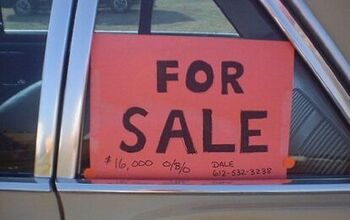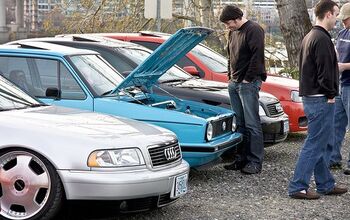How to Buy a Used Car - Pt. 1: First Contact
Used cars give automobile buyers the best possible bang for the buck– except when they don’t. As a professional dealer, I could tell you stories of used car calamities that would make public transportation seem like the only sensible option. Tales of stitched together death traps that looked as new as the day both cars were born. Cars with supposedly clean registration papers that turned out to be hotter than Peachtree Street in mid-August. Instead, I’m going to tell you how to buy a used car without getting your proverbial clock cleaned.
Finding an appropriate used car is a pretty simple business: decide what kind of car you want, research it online (especially model and brand-specific enthusiasts’ sites) and then go out and find one.
You can find a great car at a variety of sources: private, owner, independent used car dealer, used car superstores, new car dealer; even a “buy here / pay here” lot might stock a great vehicle or two (credit the law of averages). On a percentage basis, I’ve found that private owners and independent dealers offer the best bang for the buck. Conversely, your neighborhood impound lot or public auction is a no-no nadir.
When you make contact with the seller, ask for the car’s VIN (Vehicle Identification Number). That’s the government-mandated ID code welded onto the car’s chassis (and attached elsewhere), and listed on the car’s registration papers. Thank the seller for the info, tell them you’ll call them back, and hit the ‘Net.
Plug the car’s VIN number into Carfax’s or Autocheck’s on-line database. For a nominal fee, these sites will tell you if the car’s been flooded, torched, stolen, crashed, rebuilt, salvaged or had its odometer rolled back. Equally important, it’ll let you know if the car was a rental, a fleet vehicle or had a long series of owners (i.e. sporty models with neglectful owners are financial time bombs).
This due diligence must be done, but the information is far from perfect. Any damage not filed in an accident report won’t show up. Arbitration issues can also fall through the cracks. When TTAC alum Frank Williams checked an Audi he once owned, the report made no mention of the fact that Audi
bought back the car under Lemon Law provisions.
To fill the holes in a used car’s mission critical history, it pays to dig a little deeper.
Contact the service department at the brand-appropriate dealership and ask the service advisor for a maintenance report. By law, dealers can’t print out the information or give the owner’s name. But they CAN verbally report a car’s service history. If you’ve got the wrong dealership, contact the seller and ask where the car was serviced.
This brings us back to your most important source of car-specific information: the seller.
After you’ve secured the VIN and done your homework, call the seller back. There are dozens of excellent questions you can ask, and one you shouldn’t: what’s the price? Avoid negotiating price for the same reason you wouldn’t bid on a house without looking inside.
Here’s how I do it:
“I like to catch up on maintenance whenever I buy a car. Can you tell me where the car was serviced, what you’ve done lately and if there’s anything else I’ll need to do in the next year or so?”
“I usually have my cars inspected at ‘x’. If I like the car, would it be OK to have it inspected?”
I always use conditional words and phrases– “Can you… would… do you know…is it possible.” It’s non-threatening, and the polite approach encourages the owner to provide additional information.
Thank the seller; you’ll call them back when you’re ready to see the car in person.
If confidence is still high, it’s time to determine an appropriate price. Forget Edmunds, Kelly Blue Book and NADA. For popular late model used automobiles, eBay’s ‘Completed Items’ section is the only pricing guide that matters. Specifically, check out your prospective purchase’s green “ending price.” The number reflects the final purchase price for cars that actually sold in the marketplace.
If there aren’t any recent or enough listings, go to your local bank or credit union. Tell them you’re looking at buying a used car and ask them to print out an industry wide pricing guide called the Manheim Market Report (MMR).
The MMR lists wholesale and retail used car prices based on millions of recent transactions. Although the MMR is not for public consumption, almost all financial institutions with an auto lending department have access to this information.
Time for a bid? Nope. Time for a test drive.
Mr. Lang invites readers to share their used car buying advice and their used car triumphs and tragedies below.
He can be reached at steven.lang@alumni.duke.edu
More by Steven Lang
Latest Car Reviews
Read moreLatest Product Reviews
Read moreRecent Comments
- Kjhkjlhkjhkljh kljhjkhjklhkjh A prelude is a bad idea. There is already Acura with all the weird sport trims. This will not make back it's R&D money.
- Analoggrotto I don't see a red car here, how blazing stupid are you people?
- Redapple2 Love the wheels
- Redapple2 Good luck to them. They used to make great cars. 510. 240Z, Sentra SE-R. Maxima. Frontier.
- Joe65688619 Under Ghosn they went through the same short-term bottom-line thinking that GM did in the 80s/90s, and they have not recovered say, to their heyday in the 50s and 60s in terms of market share and innovation. Poor design decisions (a CVT in their front-wheel drive "4-Door Sports Car", model overlap in a poorly performing segment (they never needed the Altima AND the Maxima...what they needed was one vehicle with different drivetrain, including hybrid, to compete with the Accord/Camry, and decontenting their vehicles: My 2012 QX56 (I know, not a Nissan, but the same holds for the Armada) had power rear windows in the cargo area that could vent, a glass hatch on the back door that could be opened separate from the whole liftgate (in such a tall vehicle, kinda essential if you have it in a garage and want to load the trunk without having to open the garage door to make room for the lift gate), a nice driver's side folding armrest, and a few other quality-of-life details absent from my 2018 QX80. In a competitive market this attention to detai is can be the differentiator that sell cars. Now they are caught in the middle of the market, competing more with Hyundai and Kia and selling discounted vehicles near the same price points, but losing money on them. They invested also invested a lot in niche platforms. The Leaf was one of the first full EVs, but never really evolved. They misjudged the market - luxury EVs are selling, small budget models not so much. Variable compression engines offering little in terms of real-world power or tech, let a lot of complexity that is leading to higher failure rates. Aside from the Z and GT-R (low volume models), not much forced induction (whether your a fan or not, look at what Honda did with the CR-V and Acura RDX - same chassis, slap a turbo on it, make it nicer inside, and now you can sell it as a semi-premium brand with higher markup). That said, I do believe they retain the technical and engineering capability to do far better. About time management realized they need to make smarter investments and understand their markets better.

































Comments
Join the conversation
I bought my 2006 Scion Xb off a lot 2 years ago and what worked for me was finding the registration card of the previous owner in glove compartment. A quick look in the phone book and a quick call to the previous owner, who in this case had absolutely nothing to hid, told me all I needed to know. The car looked sketchy, high miles, two tone paint but I found out that the previous owner loved the car, husband sold it because he broke his foot and couldn't deal with the manual tranny and all the shifting, car was well maintained, all highway miles, factory paint job. When it came time to talk price i knew far more about the car than the dealer did, got a great deal ($7500!), love the car
IIRC, when CarFax lost a suit in 2006 (Wiki), they disclosed they were not getting data from 23 states, all the while claiming full coverage. I can't know it AutoCheck is any better, but I know I'll avoid CarFax ethics. Buy from an individual for sure, even with the first throw-away question, "Why are you selling the car?" It doesn't matter what they answer, since you only use their words to move into other questions to get them talking; sometimes they say too much. Of the used cars I've bought recently, I stay with one-state cars, preferably my own, in order to try to avoid title washes. If I can stay with my own state, then people like me will still have a one-state car when I'm finished with it. All of the guidebooks (NADA, etc.) are bad info for a buyer and designed by the industry to be inflated so that when you buy from the dealer you'll be paying top dollar. Consider an owner wanting to trade up - his car worth $10,000 on which there's still $12,000 left to pay, and his target car at $20k. The dealer gives the owner $12k for the trade by raising the new car by $2k to $22k, possibly "Addition Dealer Markup," or "Market Adjustment," or whatever... Both transactions, the trade price and the newer car price, are reported to the publishers of the NADA, Blue Book, etc., as prices paid. There's no wonder dealers are perfectly willing to work from "book" value so often - except for trade-in values. It's the system they've built that keeps used prices high.